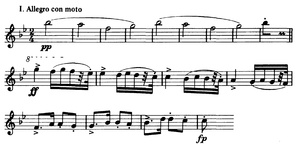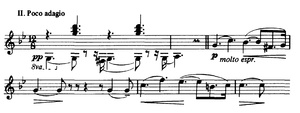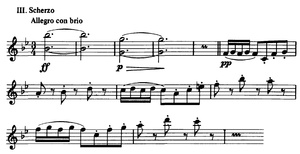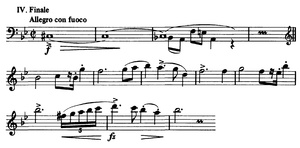2nd symphony (Dvořák)
The Symphony no. 2 B-Op. 4 is a symphony of the Czech composer Antonin Dvorak .
Emergence
“Dvořák wrote his 2nd symphony in 1865, the same year in which the 'First' was composed. A proof of the lightness of his creative work, a lightness which, as Brahms later remarked, did not rule out the danger of a lack of critical control over the abundance of ideas. The 2nd Symphony escaped this danger as little as its predecessor. As in the case of the 1st symphony, the young composer also lost sight of the score of the 'second'. When, to his surprise, it reappeared in the 1980s, the now famous Dvořák revised it with a view to publication. His publisher Simrock , however, refused to accept it, but it was successfully premiered in Prague in 1888. It was not until 1959 that the revised score was published as part of the Prague Critical Complete Edition of Dvořák's Works. "
At the time the symphony was written, the composer's love for his piano student Josefina Čermáková remained unrequited, whose sister Anna he later married.
To the music
occupation
2 flutes , piccolo , 2 oboes , 2 clarinets , 2 bassoons , 4 horns , 2 trumpets , 3 trombones , timpani , strings
1st movement: Allegro con moto
The first movement, with its sweeping harmony, is characterized by an "infinite melody" in the sense of Richard Wagner . Nevertheless, two main themes can be identified. The first begins hesitantly in the strings and develops over a tutti supported by the timpani into a moving, flowing motif. The second theme appears first in the woodwinds and is difficult to distinguish in the partly rhapsodic symphonic events. The movement closes with a moving coda that takes up the second theme.
2nd movement: Poco adagio
The second movement has a notturno-like character. Its soft instrumentation and melody are interrupted by some dramatic moments. So the beginning of the movement not only appears peaceful, but at the same time threatening due to the moving play around the chords in the strings. Then the main theme flows broadly in the strings and slowly develops. The cellos often have the task of forming melodies, which is typical for Dvořák. The longest movement of the symphony closes peacefully with a woodwind chord after a few dramatic outbursts.
3rd movement: Scherzo, Allegro con brio
The pastoral third movement contains echoes of Felix Mendelssohn Bartholdy . It is the most untypical scherzo movement in Dvořák's symphonies. The subject is rather restrained and not as joyful and popular as usual. The slowly developing main theme is finally repeated in the orchestral tutti and led to an optimistic climax with trumpet fanfares. The following middle section contains most of the folk elements, with a light woodwind theme. The movement closes slowly and cautiously after repeating the Scherzo part.
4th movement: Finale, Allegro con fuoco
The finale represents the artistic climax of the symphony. After being played in the “wrong” key of A major, a moving main theme follows in B major. Shortly afterwards, the grand cello, accompanied by string pizzicati , introduces a second vocal theme. The first theme is preferred in the following musical course, which again is not entirely in the form of a sonata , but often takes on rhapsodic form. It is processed in many ways. The progressive action ends in a triumphant coda, which gives the symphony a jubilant end.
effect
The world premiere took place on March 11, 1888, over 20 years after its creation. Adolf Čech conducted the Prague National Theater Orchestra. The work was largely positively received.
The 2nd symphony is one of the master's early, not yet fully developed works. Nevertheless, many typical traits of Dvořák's symphonies and a skill for mastering the symphonic form can already be determined. Although the work is one of Dvořák's seldom performed symphonies today, it is still very popular.
literature
- Alfred Beaujean in: Lexicon Orchestermusik Romantik , ed. von Wulf Konold, Munich: Piper 1989, Vol. 1, 187-189.
- Christoph Hahn, Siegmar Hohl (eds.), Bertelsmann Konzertführer , Bertelsmann Lexikon Verlag, Gütersloh / Munich 1993, ISBN 3-570-10519-9
- Harenberg concert guide , Harenberg Kommunikation, Dortmund, 1998, ISBN 3-611-00535-5
Web links
- 2nd Symphony (Dvořák) : Sheet music and audio files in the International Music Score Library Project
Individual evidence
- ^ Alfred Beaujean, p. 188




